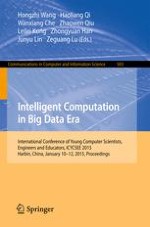2015 | Book
Intelligent Computation in Big Data Era
International Conference of Young Computer Scientists, Engineers and Educators, ICYCSEE 2015, Harbin, China, January 10-12, 2015. Proceedings
Editors: Hongzhi Wang, Haoliang Qi, Wanxiang Che, Zhaowen Qiu, Leilei Kong, Zhongyuan Han, Junyu Lin, Zeguang Lu
Publisher: Springer Berlin Heidelberg
Book Series : Communications in Computer and Information Science
